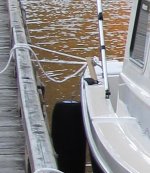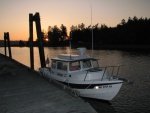The lock walls are just that, a big wall with out any bumps or protrusions that would catch the edge of a barge being pushed by a tug two barges back. In the wall are slots and in the slots are the floating bollards. The slots are probably 50 feet apart.
I have not been though the locks on the Snake/ Columbia, but I've watched a lot of boats go through, and I've been through a bunch of other locks. The Snake locks were built in the 1960s and represent the end of design in lock construction - ie from the older locks like the Rideau in Canada built in the 1820s to the Eire Canal built around 1900 to the TVA built locks in the 1930s. I think that system you will go through the highest lift lock in the country. The newer locks are easier, even if taller. I find the easy way is to have a 10 foot dock line fastened to the cleat just forward the rear of the cabin. You pass the line over the floating bollard, and hold the free end which holds the boat against the wall. Have good gloves, leave the motor at idle, and be ready to release the line if the bollard hangs up. We put a big bumper on the cleat under the helm, and one a few feet forward of the rear of the boat. The C-dory's rear cleat is too far back and the bumper skids out behind the boat. I put a chrome door handle about a foot forward of my gas filler on the inside of my gunnel and clip my rear bumper on that. Two big bumpers work nicely to hold you away from the rough wall. If you get a lot of wind or current the bow tends to pull out. If that happens, my wife holds the line and I work a boat hook to push off the stern and keep us balanced. I've seen people go forward with a line, but the C-dory is too short to reach two bollards and having someone hold it amidships is too risky in my opinion.
The Corps has set passage times for recreational boats through the locks at 9 am, noon, 3 pm and 6 (I think.) I'll be in Lewiston, ID next week and will check in the Corps office and see if they have any other controls. When I was in the sailboat group 10 years ago members were going through the locks frequently. The local name is the "Snake Lake" because it is a long winding lake with wind up or down the lake which makes for a lot of tacking practice
Chuck


